See likes given/taken
| Post info | No. of Likes |
|---|---|
|
Re: Active hunting tips?
Quote If i shoot a animal or human that's at south-east, north-west the range is doubled? Like if the diagonal tile be 4m instead of 2m when it's a horizontal or vertical tile? I just checked the code. Range is not doubled, yet it varies based on the angle you are aiming at. For example, if your target is 6 tiles to the south and 2 tiles to the east, the actual distance is about 6.32 tiles. March 16, 2021, 05:50:09 PM |
1 |
|
Re: Active hunting tips?
I think PALU got it right. Technically speaking: Character and NPC movement code uses integers, but missile trajectory code is based on floating-point calculations.
March 17, 2021, 08:07:27 AM |
1 |
|
A very draft of textilecraft -- fibre processing on its' way
So we're adding fibre processing, from harvested plants into yarn, starting with nettles. It's a complex feat(ure) all-in-all and the things briefed here can change as we proceed. Now we're in the middle of brainstorming, study, coding and testing the initial mechanics - and also making changes to existing stuff to the extent that allows this type of new material processing in the first place. Starting with nettles we'll add few new habitats (ponds and wetlands) for them so that the newly featued usefulness will be practical in the wilderness conditions. Nettle harvesting also needs to be changed so that they can be harvested way earlier than currently, without seeds naturally, but in good length for fibre extracting. Fibres obtained will be probably categorized as PLANT item type, for easier spotting and selection from the inventory. For all the fibre processing and spinning yarn it's likely that we'll feature a completely new skill: textilecraft. The fibre processing in general will go through retting, drying and extracting fibres. We'd like to feature water retting based on the temperature, so it can be faster or slower depending on the weather (ie. water temperature), and becoming impossible in the freezing weather. We'd also like to make it possible to extract fibres from (fresh) nettles simply by hand without retting process required. It takes some time, but that's how you would craft a fishing line in the wilderness within few hours. For producing larger quantities of fibres the water retting would be the way to go, of course. Fibres can be spun into yarn either by hand, or with a spindle. The both options will be available. Crafting a spindle is simple, but the actual spinning is something you need to practise. Textilecraft skill would come in handy there, as the beginners surely don't produce yarn all that fast at all. That's some of the to-dos (and actually some dones also) from top of my head to come up with satisfying fibre processing. With this addition I found it better to proceed kind of backwards... So at first I've got some (magically generated) nettle fibre, and a spindle - a new craftable item. Textilecraft menu is set up with the initial options. Retting, drying and extracting are mere placeholders, but spinning yarn is being coded now. Productions times and yield and internal properties of the bundles of fibre, and yarns are on the table. After the spinning code is ready, it's time to concentrate on the preceeding steps. Here's a very draft screenshot where I'll try to code Kuitu Kaumolainen through spinning his first nettle yarn. There's bundle of nettle fibres and spindle on the ground. 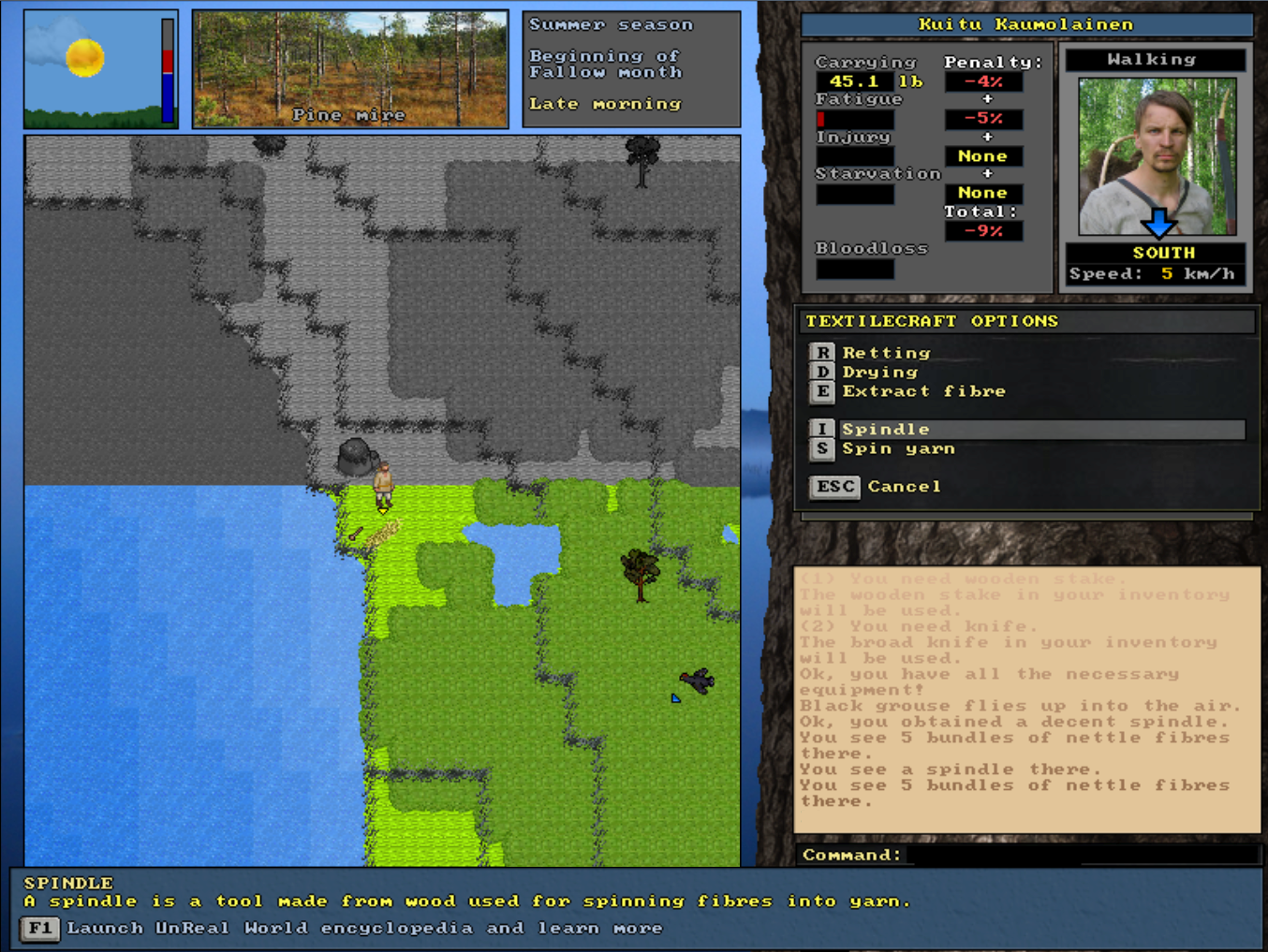 These are future additions - not yet functional in current version 3.63. March 17, 2021, 11:04:37 AM |
1 |
|
The Moon and The Crust
Erkka was visiting me last weekend and some really exciting weather engine achievements and accompanying real life adventures were made. Now there are two new essential weather features on the table - both still somewhat under construction, but most likely to be seen in the next version. And the features are... * The moon. Our weather engine now models the moon in detail, with its' changing phases and moonlight affecting to the nighttime visibility and brightness. Lots of tuning is still pending, but we can already see that the full-moon nights in the game will be a different experience. Especially during the darkest seasons moonlight can be a of great help and extended the available hours for working, hunting or travelling. Just have a look at the screenshot compilation below. 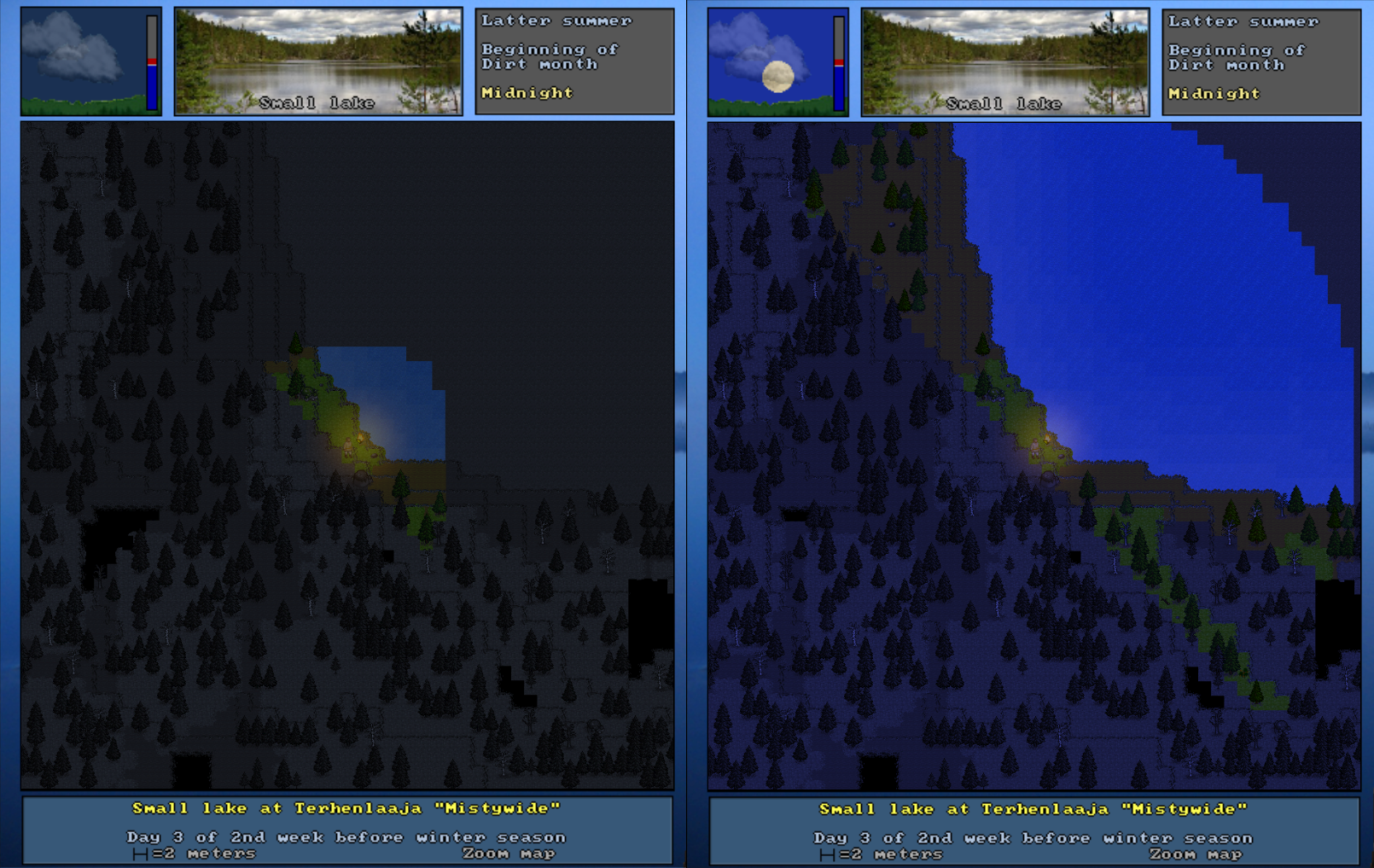 Left: A casual midnight by the lake in dirt month as it appears currently in the game. Right: The same scenery with the new moon code in action. It's full moon and our nighttime visibility is a much different. * Snow crust Snow crust is a springtime phenomena where surface of the snowpack becomes so hard that it can completely support a walking or skiing person. The crust results from partial melting of the snow surface by warm spring day sunlight followed by re-freezing when the temperature drops again, usually after the sunset. The crust normally only lasts for part of the day, but being able to travel on snow without sinking in there at all is a great asset for a hunter. Elks were traditionally hunted on skis during crust as it can't support the heavy animals and hunter gliding on crust with skis now became much faster than their prey. Lots of work is still needed before snow crust support is all coded, but that's the intention. Now it also requires proper snow penalty to be added for NPCs and animals, and reworking the skiing code to some extent too. (And if you were thinking of skiing NPCs so were we.) The last weekend it was both full moon and snow crust possibility, so we also went experiencing these things in real life. Naturally these both are familiar experiences already, and as countryside kids we've learned possibilities of snow crust for work and leisure all the way from our childhood. But if you'd like to see the magic of skiing in moonlight without any artificial light, or get an idea about difference between skiing in slushy spring snow compared to the crust, we've got a short videoclip for you: https://www.youtube.com/watch?v=JOcb_cm5UkE March 29, 2021, 05:36:42 PM |
1 |
|
Re: The Moon and The Crust
In UrW simulation there are two factors to the visibility: 1) how far you can see 2) how bright / dim is the area you see (there, naturally, is a defined relationship between these two. But, speaking of the simulation, they are different variables) If we use these variables to make sense of the real world phenomena, I think moonlight having snow on the ground doesn't affect variable 1. But it might slightly change variable 2. The main effect of having snow on the ground is that it creates a different kind of contrast. Let's imagine it this way: there is no snow on the ground, you are standing on a middle of a field, looking at the edge of the forest. Next to the forest there is someone, maybe a person, maybe an animal. But the forest behind that creature is dark in color, and so is the creature. So you have very little of visual cue to distinguish the dark shape of the creature against the dark background. Now, imagine the same scene with snow on the ground, and also a layer of snow on tree branches. Suddenly the background appears not dark, but more like dimly glowing blueish-white. But there is not snow on the creature, the creature is dark. In these conditions it is a lot easier to spot "aha, there is something there, near the edge of the forest!" And I think something like this happens in UrW simulation, too. April 08, 2021, 02:08:56 PM |
1 |
|
Re: A very draft of textilecraft -- fibre processing on its' way
Very exciting update, I've been looking forward to this one for a long time! I practice textile arts as a hobby in real life and have done some research into historical northern European textiles including the trading value of materials and the times it would take to craft different items. If dyeing is ever added as a craft, I have a fantastic research study I've found that I'd be happy to share as a reference. If you have any questions to ask from someone who's done the skill in real life or just want someone to brainstorm textile ideas with, please feel free to contact me! April 10, 2021, 02:00:58 AM |
1 |
|
Fibre processing continues with retting and some spin-off features
By now spinning code is all done and tested and polished, and we're happily able to spin both nettle and hemp yarn. With some new flora_*.txt tags added it's actually possible to add fibre yield for any flora_*.txt plant, although the textilecraft processes are modelled for nettle and hemp. But yes indeed for example flax as a new fibre source can be added relatively easily. We've also added straw, a mere stalk of certain plants, as a new item type. Straws will be a byproduct of threshing plants such as nettles and hemp, but with a flora_ tag of their other plants can be also given straw yield. Straws don't (yet) have specific use of their own but do serve as material for fibre processing. Straw items were added for the sake of being able to thresh valuable plants for seeds and leaves first, and still have the straw remaining for fibre. And now there's "retting" added for textilecraft options. It's a process for separating the fibres from the stalks of harvested plants, and the first and foremost option of them all. Retting is done by soaking the plants in the water for several days. The soaking needs to be done by open water and the sufficient soaking time depends on the water temperature, varying from 5 to even 25 days. The warmer the water, the faster the retting process is. The retting doesn't occur at all in very cold water so it can't be done for example in the winter. However, nettles are a speciality and you can peel fibres from them by hand without retting, but it's relatively slow and mostly used only if small amount of yarn needs to be spun. Now the remaining steps to do on our way to completely finished textilecraft system for fibre processing would be drying the retted plants, and extracting the fibre. So let's continue ... These are future additions - not yet functional in current version 3.63. April 19, 2021, 04:48:22 PM |
1 |
|
Fibre processing done
So, the system of processing fibres from hemp and nettle into yarn is now all coded. Small adjustments remain, but we've happily accomplished mechanics for all the work phases and necessary adjustment to data structures. Adding this system of textilecraft has been likely the most laborous single feature to code in the upcoming version. With several other features regarding tying equipment we can talk about sort of cordage overhaul. Soon enough I'll be posting more organized entry about the whole system with screenshots, but now let's quickly cover what hasn't been covered in the earlier textilecraft news. So, the final two additions to textilecraft system were drying the retted plants and the actual extracting of fibre. Drying is simplified. It takes about a week for retted plants to dry before extracting the fibre can be proceeded. And you can basically set them drying anywhere. The idea of extracting the fibres is to break the dried retted stalks so that the woody core shatters and falls away leaving the loose fibres free. Traditionally this was done with a special device called ‘loukku’, but in the game we use more primitive method of beating the stalks for example with a club on a solid working surface. The requirements are similar to softening hides as a last step of tanning; beater and a working surface. Extracting fibres is hard physical work and commonly carried out with several people working together. If you have companions around they will help you with the task. After the breaking phase, obtained bundles of fibre are scraped free from remaining coarse parts and extraneous material. This is done in steps, first removing the biggest extraneous parts and gradually proceeding towards the finer ones. Traditionally special tools, combs and brushes were used to clean the bundles of fibre as effectively as possible. In more primitive fashion it can be also done by whisking, rubbing and whacking the bundles against a hard surface, or with tools at hand. In the game this is the method used, and the equipment available for breaking is applied here as well. All these required phases are done with single textilecraft option. Extracted fibres are obtained in small bundles, eg. "bundle of hemp fibre". These items are categorized as PLANT type in character's inventory. As mentioned before, nettle fibres can be also extracted directly from the stalk by hand even without retting. Although it's slower to mass produce fibre that way it can be useful option when only a small amount of fibre is needed. To do it, simply use extract option directly to freshly harvested nettles. The nettle stem is crushed by hand, and the fibres carefully stripped off. Character's expertise in textilecraft affects to required working time and amount of usable fibre extracted. So as your mastery in textilecraft increases you can expect to get higher fibre yield in shorter time. These are future additions - not yet functional in current version 3.63. May 06, 2021, 04:19:40 PM |
1 |
|
Re: Fibre processing continues with retting and some spin-off features
This is a topic I've seen mentioned in the forums a few times before, and decided not to comment (for I've thought that this will be discussed again, once the need to feed livestock gets implemented in the game). So, not going to go into details of this discussion now, when plans for "the need to feed livestock" are just that - plans, and not yet in the works. Just a short mention, one point: As a person living in the countryside, with decades of first-hand experience in feeding domestic animals like horses, cows and sheep, and as a person who has read something about the history of animal-rearing in Finland, and also has first-hand experience about the old traditional breeds like the Finnhorse and Finncattle, I'd like to make a point: "hay for food, straw for bedding" is a relatively modern invention. 1000 years ago it was more like "feed your animals with what ever you managed to gather in the summer", which meant things like dried bunches of broadleaved saplings, moss, straw, and yes - wild hay. (For bedding it was most likely peat and moss). I've seen my own Finnhorses deliberately choosing to eat straw when hay is also available. Those old breeds have digestion all geared towards survival, they like to chew tree bark etc. Finncattle digestion is more like a reindeer, than a modern cow bred for maximum milk production. Oh well. And in case someone disagrees and feels a need to continue this discussion, please do so in "general" or "off-topic" sections instead of dev.news which is for announcing features Sami is working on, not about going into details discussing future plans. May 10, 2021, 06:23:36 PM |
1 |
|
Sneak preview of textilecraft system with screenshots and additional insight
Time for a little sneak preview with our textilecraft test character Kuitu Kaumolainen. Some of the stuff mentioned here has been mentioned before, but a summary about textilecraft is in place now. With some sdditional insight and sidetracking included. So, the biggest single addition to the upcoming version is featuring mechanics to extract fibres from certain plants and process them into yarn. For this, a new TEXTILECRAFT skill was created, and lots of spin-off features regarding fibre processing and cordage also followed. Fibres can be extracted from nettle, hemp and flax - which has been added as a new cultivated plant. Let's start from there ... Flax Flax is an old cultivated textile plant, but in Iron-Age Finland it wasn't even as commonly grown as hemp. One reason for this is that flax doesn't survive in the very north so in the game it's grown only by certain cultures south of Kaumo. As a curiosity, the finnish word for flax ('pellava') originally meant the nettle plant ('nokkonen') which speaks about importance of this age-old wild source of fibre. But nevertheless, flax is in the game now and it can be grown, harvested and processed for fibre. 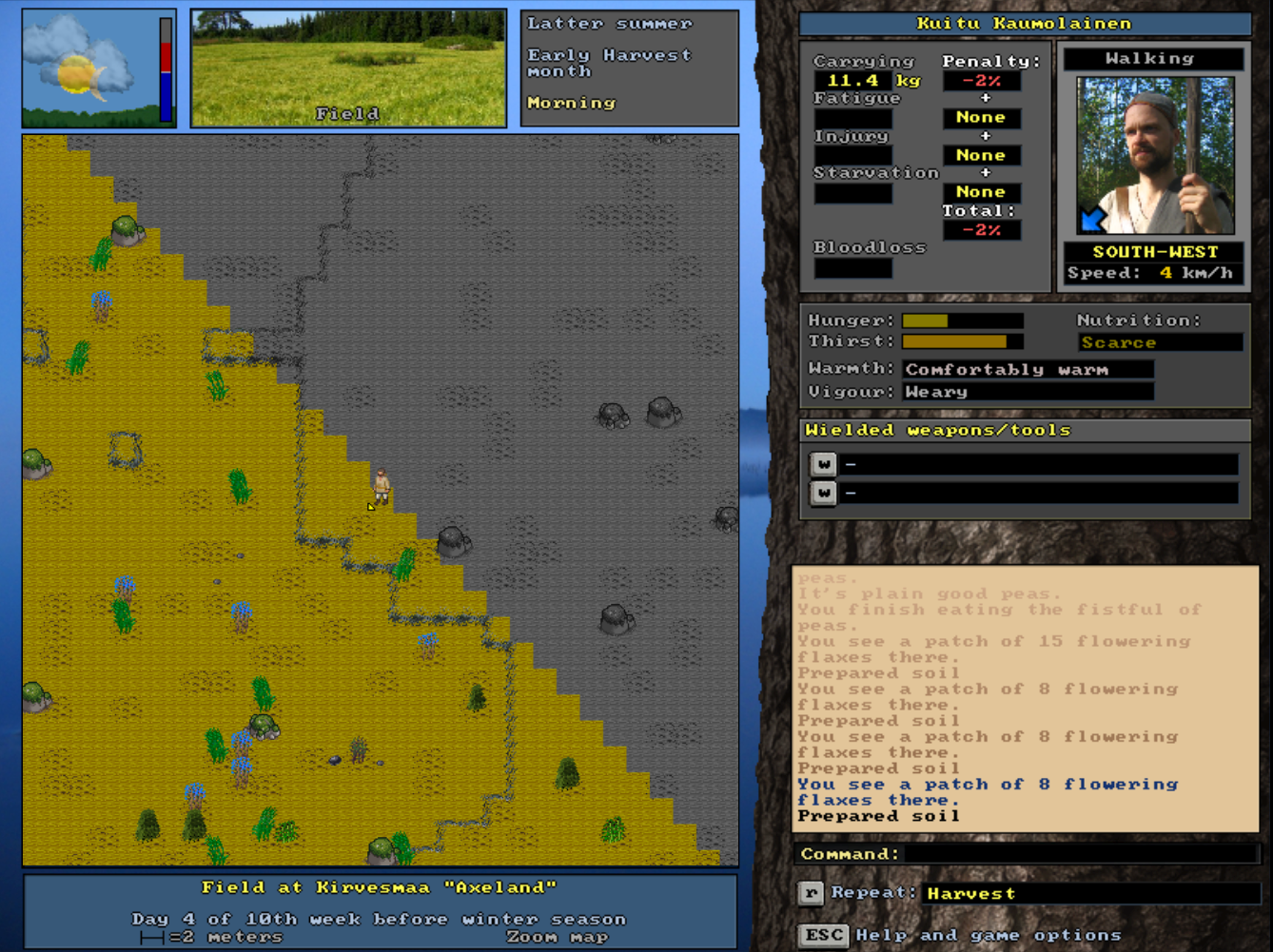 Kuitu Kaumolainen has found his way to Kiesse, a region where flax is grown. At Kaumo where he's from they only produce nettle or hemp fibres. Blue flowering flax is easily spotted from the field, and it could be harvested for fibre already. Textilecraft options Processing plant fibres into yarn involves several stages of work, and it's all done by using your TEXTILECRAFT skill. Character's expertise in textilecraft affects to required working times and the amount of usable fibre or yarn produced. After the plants are harvested the fibres must be then separated from the plant's stalks. This process is called "retting", and it is done by soaking the plants in the water for several days. Sufficient soaking time depends on the water temperature, with the warmer being faster. 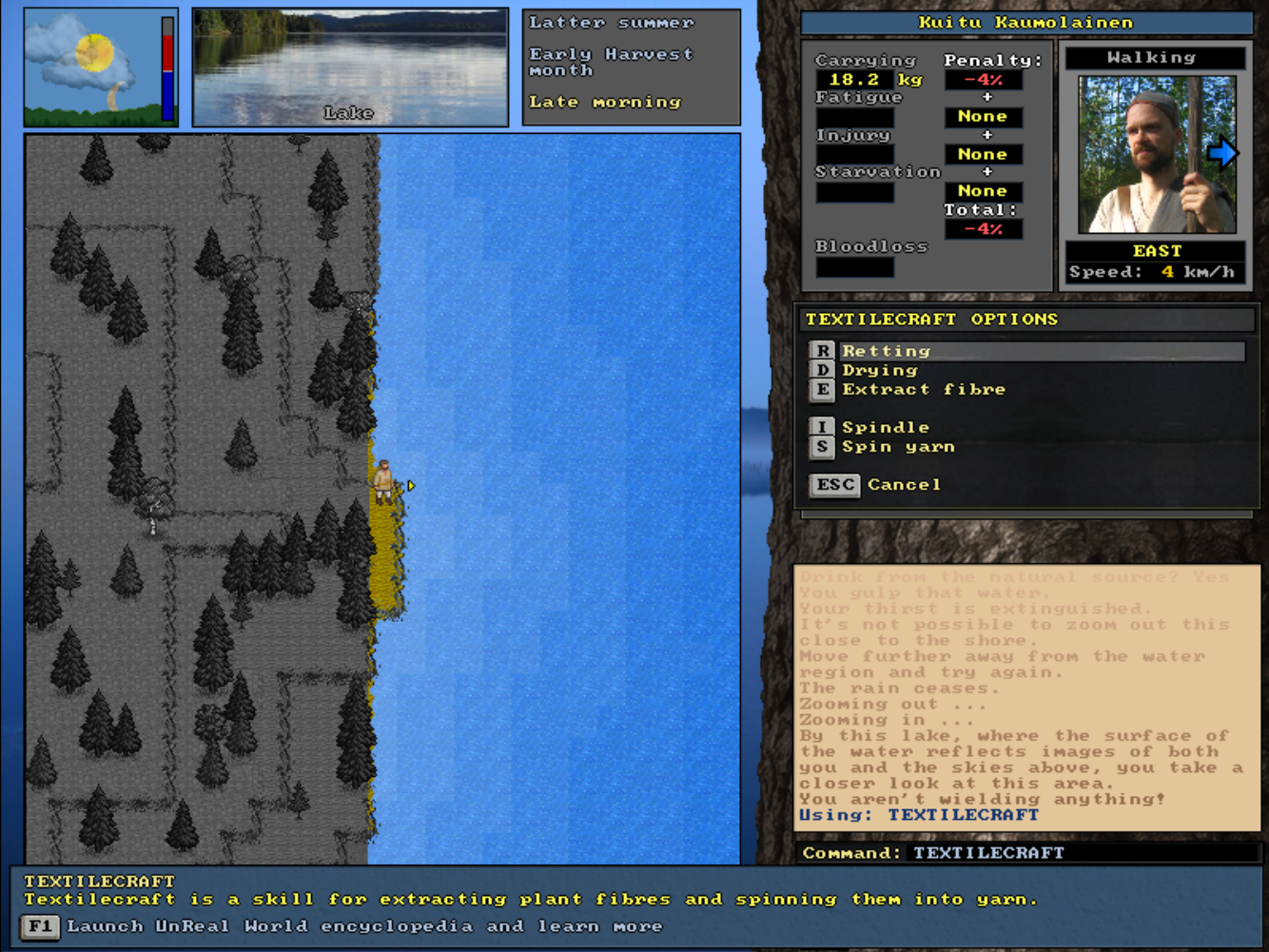 Kuitu Kaumolainen harvested 100 flaxes and headed by the lake to start retting the stalks. Here you can see all the textilecraft options to proceed with fibre extracting and spinning them into yarn. Extracting fibres is hard work It took two weeks for Kuitu's flax to soak properly. After that it took one more week to dry them. And only then Kuitu can start extracting the actual fibre from the stalks. Extracting fibres is done by breaking the dried retted stalks so that the woody core shatters and falls away leaving the loose fibres free. The stalks are beated for example with a club on a solid working surface. Extracting fibres is hard work and commonly carried out with several people working together. Traditionally there has been a custom to arrange specific work parties for processing fibres of each village together with the neighbouring people. And in the game your companions can actually help you with the task. Obtained bundles of fibre are then scraped free from remaining coarse parts. Traditionally special tools were used, but it can be also done by rubbing and whacking the bundles against a hard surface, or with tools at hand. 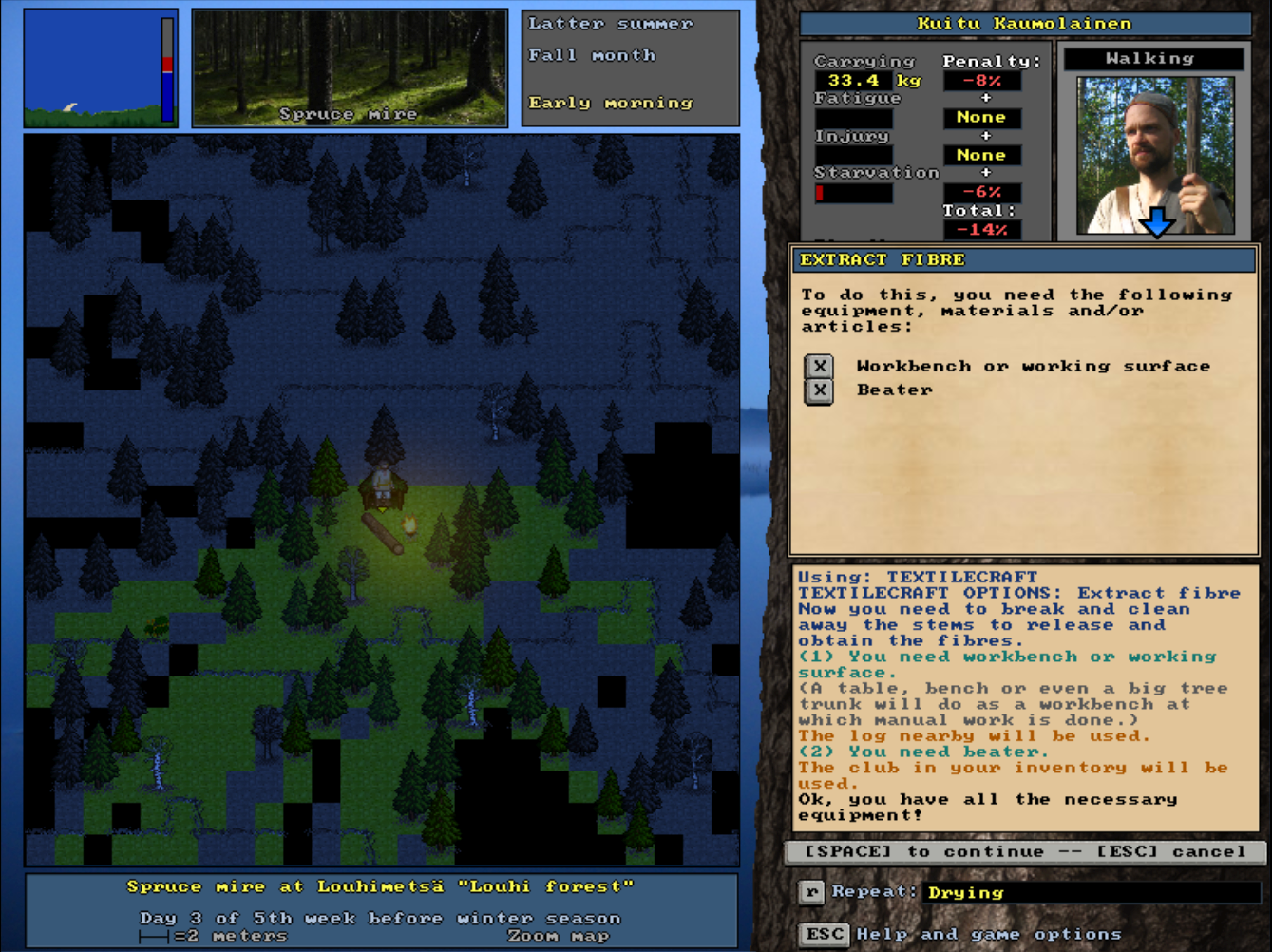 Kuitu starts extracting fibres from the dried retted flax stalks at his shelter. He is about to beat the stalks with a club on top of a log. These dried retted stalks could have been also stored for future and the fibre extracted when there's time and need for that. Spinning yarn It took lees than half an hour to extract the fibres from his 100 flax stalks and Kuitu got 16 bundles of flax fibre. Fibres can be then spun into yarn either by hand, which is slower, or using a spindle. Spindle is also a new craftable item, and very easy to make. So Kuitu crafts a spindle and starts spinning. He decides to go for full length yarn. When starting spinning it is possible to choose how long yarn you wish to spin on one go. 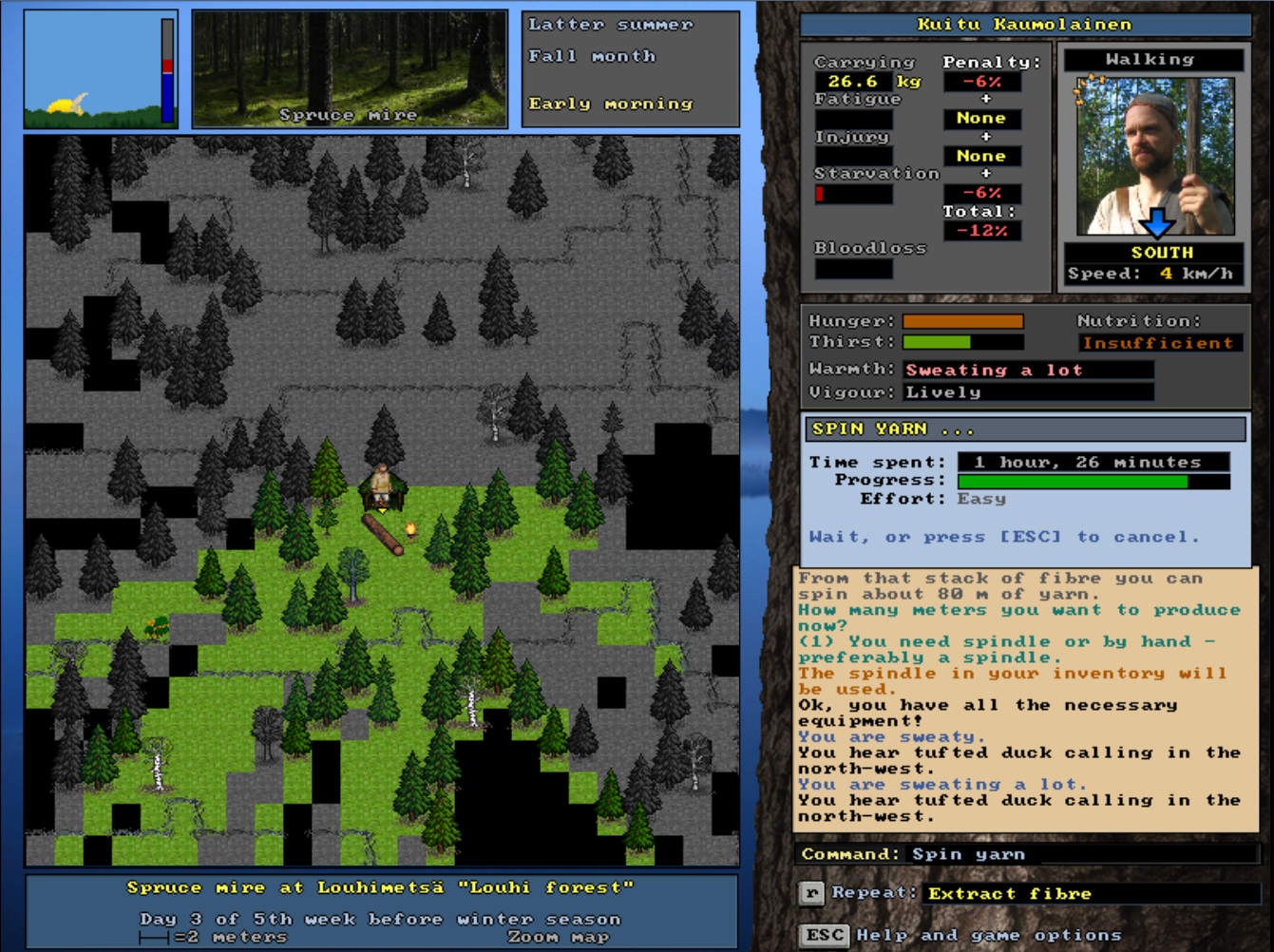 Kuitu manages to spin 80 meters of linen yarn in less than two hours. It could be then used in crafting of different items such as loop snares, arrows - or fishing rods. Nettle specialities In the next version it will be also possible to craft fishing rods, and hooks out of wood or bone. And a working fishing rod naturally needs a line too. Now Kuitu has his linen yarn which could be used as line, but the whole process of extracting flax fibres with retting and drying took weeks. That's quite a long time if there's an urgent need for little piece of yarn. Luckily there's also faster wilderness condition option for utilizing plant fibres - and that is a nettle. Nettle fibres are a speciality as they be extracted directly from the fresh plants without retting and drying processes. To do it you can simply use "extract fibre" option directly to freshly harvested nettles. This method takes more time, but is an useful option when only a small amount of fibre is needed. The nettle stem is crushed by hand, and the fibres carefully stripped off. It doesn't take long before Kuitu finds some nettles. Textile plant harvesting is made possible for fibre even when they are still growing. 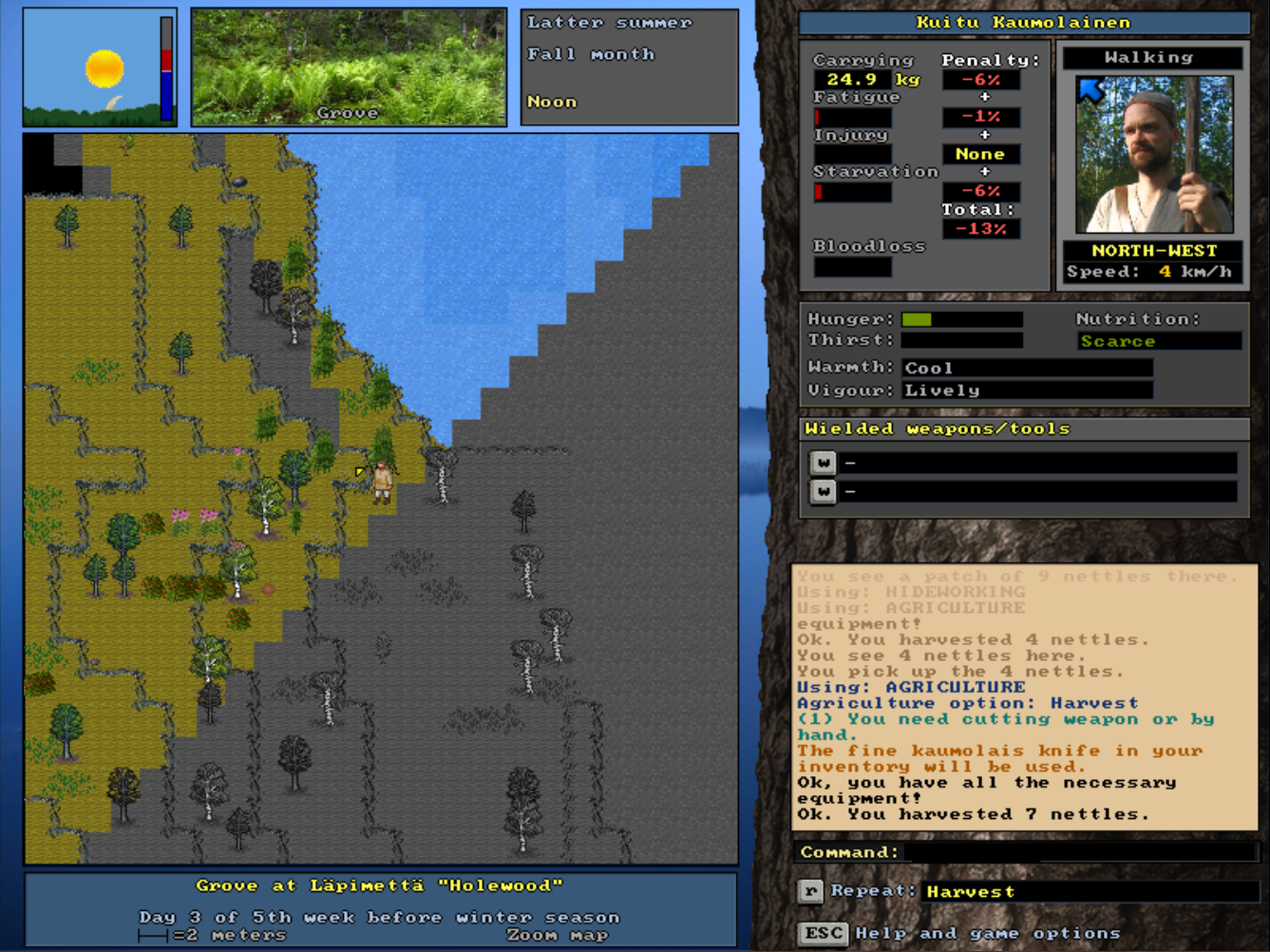 Kuitu harvests some nettles. Then he simply extracts the fibres by hand, and spins some nettle yarn. If he would like to produce a lot of yarn, this would be too slow to be practical, but now he's only after fishing rod line, Wooden hook, nettle yarn - and baits Kuitu finds a slender tree trunk, fashions a wooden hook out of a branch, and proceeds to assemble a fishing rod. Now we should mention that In the upcoming version usage of baits in fishing is also featured. Using baits is not necessary, but naturally highly recommended. Catching a fish every now and then without a bait is still possible, but for reliable rod fishing and decent catches baits are now quite essential. You can use pretty much every food item as a bait and portion of the selected item will be used during the fishing attempt. Pieces of raw meat and fish can be considered decent baits for predatory fish, but for example crumbs of bread may also work for some fish. You can also use a whole small fish, eg. roach or perch, in order to attract a bigger predatory fish. With this addition in effect the type of fish caught with rod fishing is now more dependant on the baits used. It's not likely that you'll catch a pike with an empty hook, but having a small roach as a bait might work. And that little roach might have been caught with quite moderate bait such as bread crumb, or even with some tasty vegetation. 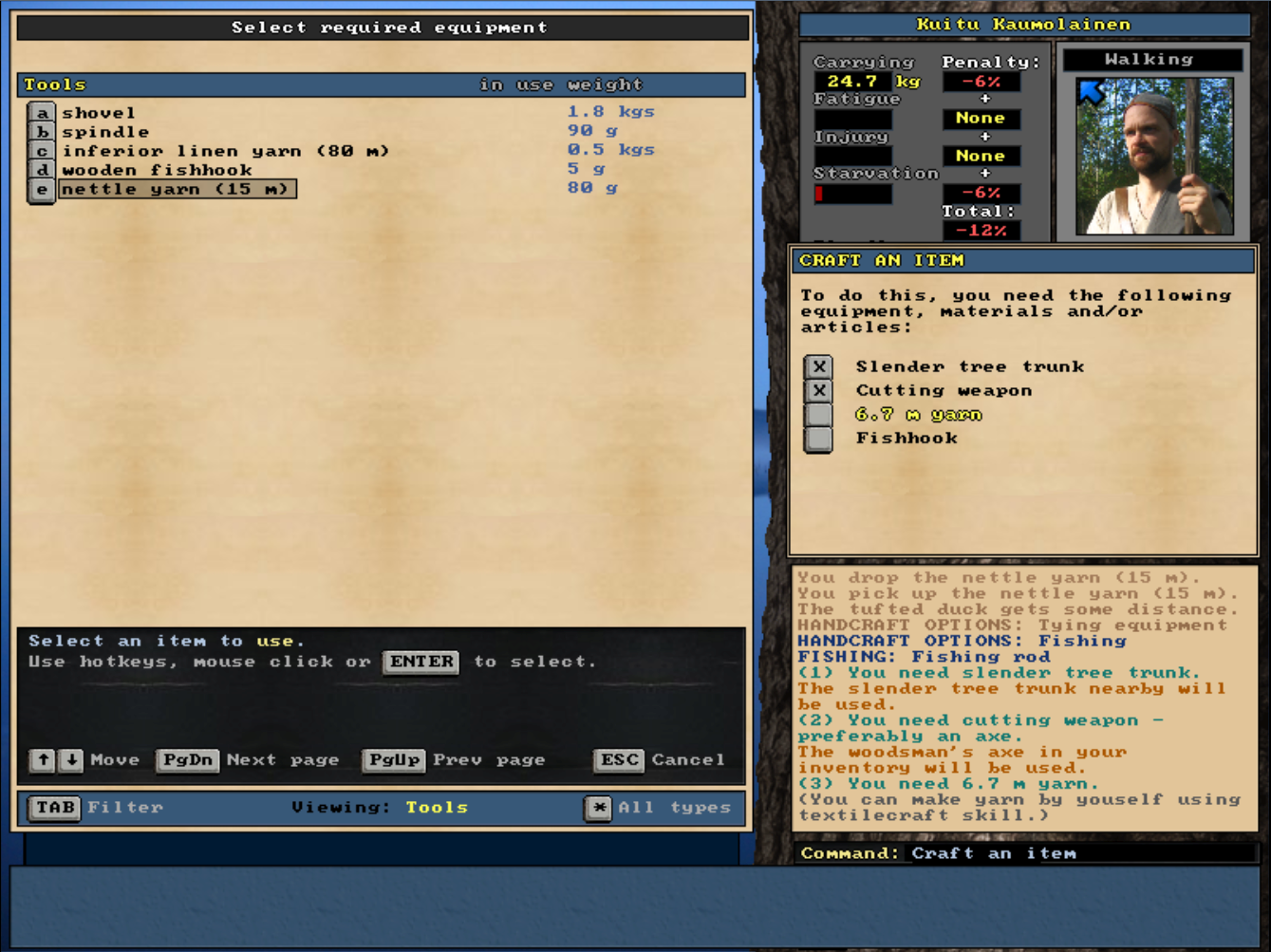 Kuitu makes his survival fishing rod, with a wooden hook and nettle yarn. The work with the several less laborous features continues but we're getting closer to release every day. It's always quite impossible to say when everything is completely wrapped up and working, but maybe - just maybe - we might have this version out in june. Cheers! For those who are more curious about the real life practises here's a short documentary in Finnish showing how the flax is processed. Having read the above I trust you will understand what is happening even without subtitles. The gear used differs slghtly from the more primitive method of the game, but the steps are the same; sow, harvest, ret, dry, extract, spin. https://www.youtube.com/watch?v=TNFD_CUlxZU May 11, 2021, 03:52:38 PM |
1 |


